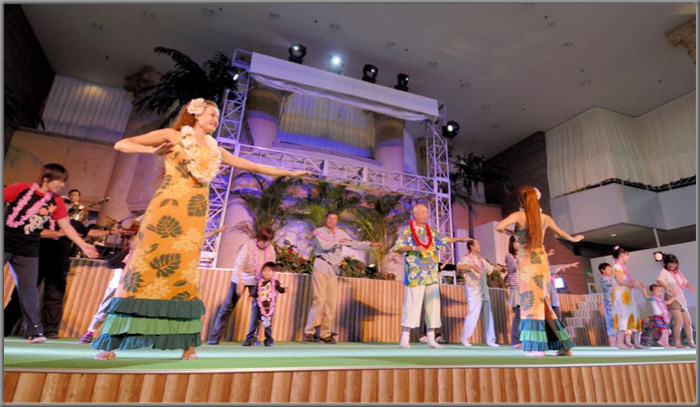Home > Highlighting JAPAN > Highlighting Japan NOVEMBER 2011 > Paradise Re-Found
Highlighting JAPAN
COVER STORY: Variations on a Theme
No reservations are required for this fun opportunity to dance the hula.
Credit: YOSHIFUSA HASHIZUME
Paradise Re-Found
Spa Resort Hawaiians in Fukushima Prefecture has re-opened for business following repair work on damage caused by the Great East Japan Earthquake. Toshio Matsubara reports.
Located In Iwaki City, Fukushima Prefecture, Spa Resort Hawaiians is popular for its many large indoor and outdoor onsen (hot spring) baths and pools, and for its shows on a poolside stage by the Hula Girls. The resort was closed after cracks formed in the large onsen pool due to the Great East Japan Earthquake. Repairs on some facilities with less severe damage were completed and operations resumed on October 1, with the entire resort scheduled to reopen in January 2012.
Joban Hawaiian Center, the forerunner to Spa Resort Hawaiians, opened in 1966. Iwaki once flourished as a coal-mining town, but demand for coal fell drastically due to competition with imported coal and the switch to petroleum fuels. Joban Hawaiian Center was developed to offer new employment opportunities to coalmine workers who had lost their jobs. To attract more visitors, daughters of coalmine workers received intensive training in hula dance so they could start performing shows, which became the major feature of the facility. A 2006 hit movie in Japan titled Hula Girls, named best film in the 2007 Japan Academy Awards, depicted the true story of the team's origins and success. The members, who were known simply as the Hawaiians' dancers until then, came to be known as the Hula Girls, and became well-known nationwide.

The Hula Girls perform a rhythmic Tahitian dance.
Credit: YOSHIFUSA HASHIZUME
"Hula dancers are supposed to smile while they dance," she says. "At the start, we weren't sure if we should smile at evacuation centers. But the people greeted us warmly, some were in tears thanking us, and they gave many words of encouragement. They cheered us up more than we cheered them up. We hope to deepen this bond even further, on the stage."
Their shows combine four types of dance, ranging from elegant hula to rhythmic Tahitian dance, fascinating their audiences. Tatsuo Kuzunuki, who comes from Kanagawa Prefecture to see the group perform at least 120 days each year, describes their charms with a smile.
"I suffered a serious illness in the past," Kuzunuki says, "but their performances give me energy. I watch my health daily because I want to come here and see them perform. I look forward to the shows each time."
| Access and Admission | |
| Access: | • About 1 hr. and 50 mins. by car from Tokyo via the Joban Expressway (free bus services are available for hotel guests of Spa Resort Hawaiians) • Yumoto Station is about 2 hours by train from Ueno Station on the JR Super Hitachi express. The resort is about 10 minutes from the station via the free bus service or taxi. |
| Website: | http://www.hawaiians.co.jp/english/index3.html |
© 2009 Cabinet Office, Government of Japan






